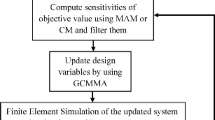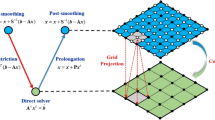Abstract
One challenge of solving topology optimization problems under harmonic excitation is that usually a large number of displacement and adjoint displacement vectors need to be computed at each iteration step. This work thus proposes an adaptive hybrid expansion method (AHEM) for efficient frequency response analysis even when a large number of excitation frequencies are involved. Assuming Rayleigh damping, a hybrid expansion for the displacement vector is developed, where the contributions of the lower-order modes and higher-order modes are given by the modal superposition and Neumann expansion, respectively. In addition, a simple (yet accurate) expression is derived for the residual error of the approximate displacement vector provided by the truncated hybrid expansion. The key factors affecting the convergence rate of the truncated hybrid expansion series are uncovered. Based on the Strum sequence, the AHEM can adaptively determine the number of lower-order eigenfrequencies and eigenmodes that need to be computed, while the number of terms that need to be preserved in the truncated Neumann expansion can be determined according to the given error tolerance. The performance of the proposed AHEM and its effectiveness for solving topology optimization problems under harmonic excitation are demonstrated by examining several 2D and 3D numerical examples. The non-symmetry of the optimum topologies for frequency response problems is also presented and discussed.

























Similar content being viewed by others
References
Allaire G, Michailidis G (2018) Modal basis approaches in shape and topology optimization of frequency response problems. Int J Numer Meth Eng 113(8):1258–1299
Andreassen E, Clausen A, Schevenels M, Lazarov BS, Sigmund O (2011) Efficient topology optimization in matlab using 88 lines of code. Struct Multidisc Optim 43(1):1–16
Bathe KJ (2014) Finite element procedures, 2nd edn. Prentice Hall, Watertown
Behrou R, Guest JK (2017) Topology optimization for transient response of structures subjected to dynamic loads. In: 18th AIAA/ISSMO multidisciplinary analysis and optimization conference, p 3657
Bendsøe MP (1989) Optimal shape design as a material distribution problem. Struct Optim 1(4):193–202
Bendsøe MP, Sigmund O (2003) Topology optimization: theory, methods and applications. Springer, Berlin
Bourdin B (2001) Filters in topology optimization. Int J Numer Meth Eng 50(9):2143–2158
Bruns TE, Tortorelli DA (2001) Topology optimization of non-linear elastic structures and compliant mechanisms. Comput Methods Appl Mech Engrg 190(26-27):3443–3459
Cheng G, Liu X (2011) Discussion on symmetry of optimum topology design. Struct Multidisc Optim 44 (5):713–717
Deaton JD, Grandhi RV (2014) A survey of structural and multidisciplinary continuum topology optimization: post 2000. Struct Multidisc Optim 49(1):1–38
Díaaz AR, Kikuchi N (1992) Solutions to shape and topology eigenvalue optimization problems using a homogenization method. Int J Numer Meth Eng 35(7):1487–1502
Du J, Olhoff N (2007) Topological design of freely vibrating continuum structures for maximum values of simple and multiple eigenfrequencies and frequency gaps. Struct Multidisc Optim 34(2):91–110
Gonçalves JF, Fonseca JS, Silveira OA (2016) A controllability-based formulation for the topology optimization of smart structures. Smart Structures and Systems 17(5):773–793
Gonçalves JF, De Leon DM, Perondi EA (2017) Topology optimization of embedded piezoelectric actuators considering control spillover effects. J Sound Vib 388:20–41
Gu J, Ma Z, Hulbert GM (2000) A new load-dependent Ritz vector method for structural dynamics analyses: quasi-static Ritz vectors. Finite Elem Anal Des 36(3-4):261–278
Jang H, Lee H, Lee J, Park G (2012) Dynamic response topology optimization in the time domain using equivalent static loads. AIAA J 50(1):226–234
Jensen JS (2007) Topology optimization of dynamics problems with padé approximants. Int J Numer Meth Eng 72(13):1605–1630
Jog CS (2002) Topology design of structures subjected to periodic loading. J Sound Vib 253(3):687–709
Kang Z, Zhang X, Jiang S, Cheng G (2012) On topology optimization of damping layer in shell structures under harmonic excitations. Struct Multidisc Optim 46(1):51–67
Li H, Luo Z, Gao L, Wu J (2018) An improved parametric level set method for structural frequency response optimization problems. Adv Eng Softw 126:75–89
Li L, Hu Y, Wang X, Lü L (2014) A hybrid expansion method for frequency response functions of non-proportionally damped systems. Mech Syst Signal Pr 42(1-2):31–41
Liu H, Zhang W, Gao T (2015a) A comparative study of dynamic analysis methods for structural topology optimization under harmonic force excitations. Struct Multidisc Optim 51(6):1321–1333
Liu H, Zhang W, Gao T (2015b) A comparative study of dynamic analysis methods for structural topology optimization under harmonic force excitations. Struct Multidisc Optim 51(6):1321–1333
Liu T, Zhu J, Zhang W, Zhao H, Kong J, Gao T (2019) Integrated layout and topology optimization design of multi-component systems under harmonic base acceleration excitations. Struct Multidisc Optim 59(4):1053–1073
Liu Z, Chen S, Zhao Y (1993) Modal truncation and the response to harmonic excitation. Acta Aeronautica Et Astronautica Sinica 14(9):A537–A541
Liu ZS, Chen SH, Liu WT, Zhao YQ (1994) An accurate modal method for computing responses to harmonic excitation. Modal Analysis: The International Journal of Analytical and Experimental Modal Analysis 9 (1):1–14
Ma Z, Kikuchi N, Hagiwara I (1993) Structural topology and shape optimization for a frequency response problem. Comput Mech 13(3):157–174
Min S, Kikuchi N, Park Y, Kim S, Chang S (1999) Optimal topology design of structures under dynamic loads. Struct Optim 17(2-3):208–218
Niu B, He X, Shan Y, Yang R (2018) On objective functions of minimizing the vibration response of continuum structures subjected to external harmonic excitation. Struct Multidisc Optim 57(6):2291–2307
Olhoff N, Du J (2005) Topological design of continuum structures subjected to forced vibration. Proc of 6th world congresses of structural & multidisciplinary optimization (WCSMO-6)30
Olhoff N, Du J (2016) Generalized incremental frequency method for topological design of continuum structures for minimum dynamic compliance subject to forced vibration at a prescribed low or high value of the excitation frequency. Struct Multidisc Optim 54(5):1113–1141
Padoin E, Santos IF, Perondi EA, Menuzzi O, Gonçalves JF (2019) Topology optimization of piezoelectric macro-fiber composite patches on laminated plates for vibration suppression. Struct Multidiscip Optim 59(3):941–957
Pedersen NL (2000) Maximization of eigenvalues using topology optimization. Struct Multidisc Optim 20 (1):2–11
Qu ZQ (2000) Hybrid expansion method for frequency responses and their sensitivities, Part I: undamped systems. J Sound Vib 231(1):175–193
Qu ZQ, Selvam R (2000) Hybrid expansion method for frequency responses and their sensitivities, Part II: viscously damped systems. J Sound Vib 238(3):369–388
Rozvany GI (2011) On symmetry and non-uniqueness in exact topology optimization. Struct Multidiscip Optim 43(3):297–317
Shu L, Wang MY, Fang Z, Ma Z, Wei P (2011) Level set based structural topology optimization for minimizing frequency response. J Sound Vib 330(24):5820–5834
Sigmund O (2011) On the usefulness of non-gradient approaches in topology optimization. Struct Multidisc Optim 43(5):589–596
Silva OM, Neves MM, Lenzi A (2019) A critical analysis of using the dynamic compliance as objective function in topology optimization of one-material structures considering steady-state forced vibration problems. J Sound Vib 444:1–20
Stolpe M (2010) On some fundamental properties of structural topology optimization problems. Struct Multidisc Optim 41(5):661–670
Svanberg K (1987) The method of moving asymptotes-a new method for structural optimization. Int J Numer Meth Eng 24(2):359–373
Tcherniak D (2002) Topology optimization of resonating structures using SIMP method. Int J Numer Meth Eng 54(11):1605–1622
Vicente W, Picelli R, Pavanello R, Xie YM (2015) Topology optimization of frequency responses of fluid–structure interaction systems. Finite Elem Anal Des 98:1–13
Wang F, Lazarov BS, Sigmund O (2011) On projection methods, convergence and robust formulations in topology optimization. Struct Multidisc Optim 43(6):767–784
White DA, Voronin A (2019) A computational study of symmetry and well-posedness of structural topology optimization. Struct Multidisc Optim 59(3):759–766
Wijker JJ (2008) Spacecraft structures. Springer Science & Business Media, Berlin
Wu B, Yang S, Li Z, Zheng S (2015) A combined method for computing frequency responses of proportionally damped systems. Mech Syst Signal Pr 60:535–546
Wu B, Yang S, Li Z (2016) An algorithm for solving frequency responses of a system with rayleigh damping. Arch Appl Mech 86(7):1231–1245
Yan K, Cheng G, Wang B (2016) Topology optimization of plate structures subject to initial excitations for minimum dynamic performance index. Struct Multidisc Optim 53(3):1–11
Yi G, Youn BD (2016) A comprehensive survey on topology optimization of phononic crystals. Struct Multidisc Optim 54(5):1315–1344
Yoon GH (2010) Structural topology optimization for frequency response problem using model reduction schemes. Comput Methods Appl Mech Engrg 199(25-28):1744–1763
Yu Y, Jang IG, Kwak BM (2013) Topology optimization for a frequency response and its application to a violin bridge. Struct Multidisc Optim 48(3):627–636
Zhang X, Kang Z (2014a) Dynamic topology optimization of piezoelectric structures with active control for reducing transient response. Comput Methods Appl Mech Engrg 281:200– 219
Zhang X, Kang Z (2014b) Topology optimization of piezoelectric layers in plates with active vibration control. J Intell Mater Syst Struct 25(6):697–712
Zhang X, Takezawa A, Kang Z (2018) Topology optimization of piezoelectric smart structures for minimum energy consumption under active control. Struct Multidiscip Optim 58(1):185– 199
Zhao J, Wang C (2016) Dynamic response topology optimization in the time domain using model reduction method. Struct Multidisc Optim 53(1):101–114
Zhao J, Wang C (2017) Topology optimization for minimizing the maximum dynamic response in the time domain using aggregation functional method. Comput Struct 190:41–60
Zhao J, Yoon H, Youn BD (2019) An efficient concurrent topology optimization approach for frequency response problems. Comput Methods Appl Mech Engrg 347:700–734
Zhao X, Wu B, Li Z, Zhong H (2018) A method for topology optimization of structures under harmonic excitations. Struct Multidisc Optim 58(2):475–487
Zhou M, Rozvany G (1991) The COC algorithm, Part II: topological, geometrical and generalized shape optimization. Comput Methods Appl Mech Engrg 89(1-3):309–336
Zhu J, Zhang W, Beckers P (2009) Integrated layout design of multi-component system. Int J Numer Meth Eng 78(6):631–651
Zhu J, Zhang W, Xia L (2016) Topology optimization in aircraft and aerospace structures design. Arch Comput Method Eng 23(4):595–622
Zhu J, He F, Liu T, Zhang W, Liu Q, Yang C (2018) Structural topology optimization under harmonic base acceleration excitations. Struct Multidisc Optim 57(3):1061–1078
Acknowledgments
The authors thank Professor Krister Svanberg for providing the matlab code of the MMA optimizer.
Funding
This work was financially supported by the National Research Council of Science and Technology (NST) grant by the Korea government (MSIT) (no. CAP-17-04-KRISS).
Author information
Authors and Affiliations
Corresponding authors
Ethics declarations
Conflict of interest
The authors declare that they have no conflict of interest.
Replication of results
The matlab code of the proposed AHEM is available upon request to the corresponding authors.
Additional information
Responsible Editor: Emilio Carlos Nelli Silva
Publisher’s note
Springer Nature remains neutral with regard to jurisdictional claims in published maps and institutional affiliations.
Rights and permissions
About this article
Cite this article
Zhao, J., Yoon, H. & Youn, B.D. An adaptive hybrid expansion method (AHEM) for efficient structural topology optimization under harmonic excitation. Struct Multidisc Optim 61, 895–921 (2020). https://doi.org/10.1007/s00158-019-02457-7
Received:
Revised:
Accepted:
Published:
Issue Date:
DOI: https://doi.org/10.1007/s00158-019-02457-7




